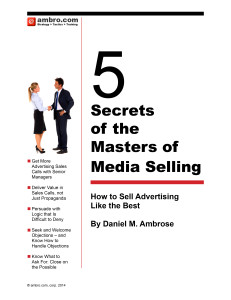Too often salespersonship is equated with manipulative tactics or worse. Real sales skills are leadership skills that are simple, available to all, and that work especially well in media sales.
Yes, sales is leading customers like discussed in Selling Power on leadership mindset. But it’s much more than that.
After all, leadership is earned, not appointed or anointed.
 Here are the five steps we teach that make for sales leaders:
Here are the five steps we teach that make for sales leaders:
- Establish Competence: Know your medium well and know how your media works for your customers. This means more than knowing the list of ad-units and their prices. In digital it means knowing the entire “ad-stack” and how each part of the stack works. In print it means knowing not just the dimensions and price of the ad-units, but all the ways ad material can be delivered and how the printing process works. If you sell print and have not toured the press-room, the bindery and inserting machinery, get a tour now. Know the research that is available to you, both on your own medium, and on the markets you operate within.
- Never lie about your knowledge. If you don’t know something, say so, and promise a prompt answer. Then use that speedy response to build your dependability (see next.)
- Be Dependable: Make promises to your prospects and customers, then follow through on them. Do things as simple as promise a return call at a particular time, then do it. Promise follow-up information with a specific deadline and be spot on. When a prospect says “no,” promise to check back at a better time, establish when that is, then do it on the dot. And remind them you promised.
- Never promise something you can’t deliver, especially results that are not in your control.
- Help Others: Humans follow others who they believe care about them. The first two points above, competence and trustworthiness are the foundations of leadership. Going out of your way to help a prospect or customer in a way that is selfless — serve them, not yourself — is the frame of the leadership house. Find and send information they might use. Answer research questions they might have.
- If your company has access to syndicated research, supply research to the small agency that doesn’t have access, or a purchaser-profile to a retailer or manufacturer (not how your media reaches their customer, but a complete buyer profile demographics, psychographics, purchase and media-use profile).
- Articulate Achievable Goals and Plans: While many media purchases are made based on colorless target audience demographics, the buyer is really trying to buy sales. Break down your prospects and your customers “needs” into real-world goals like gaining marketshare, winning new customers or increasing the average “basket” size as they say in the grocery industry. Get specific with your questions and with the background on which your proposals are built.
- For a great example of how asking powerful questions and articulating a read “How to Make an Explosively Big Sale.”
- Take the First Steps: Leadership in battle requires the leaders on the ground to lead the charge. This is why lieutenants in battle have the shortest life-spans. Leaders who have applied the first four principles above will find their platoon or their prospect following them. Those who have not done those four things will have no followers. In sales, you’ll have to offer to do work, sometimes, that hasn’t been requested. Put yourself and your time at risk to activate that “achievable goal” that you help articulate in step 4.
- Create an unsolicited proposal, in detail. Or conduct a piece of unsolicited research that will help your client better understand their prospective customers. You can utilize Survey Monkey to draft and execute a small piece of research in 24 hours from the comfort of your couch when you are done bing-watching Schitt’s Creek. Answer a question for your customer: What makes a diner try a new restaurant? What makes a customer switch peanut butter brands?
- Never focus your research on why your medium is better than a competitor. You’ll never have credibility on that. Focus your efforts on your customers’ situations; their brand reputation, their customer-path-to-purchase, their new opportunities, or how to find a competitive advantage.
Living like a leader and selling like a leader will make you a leading sales person, and your property a leader in its competitive set.

